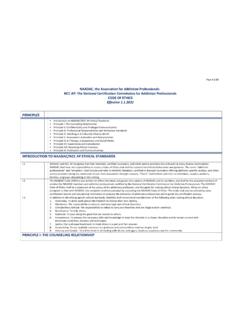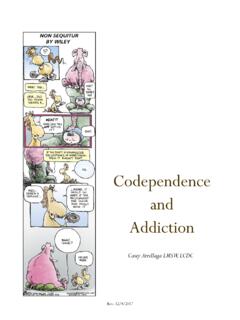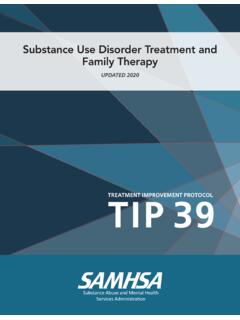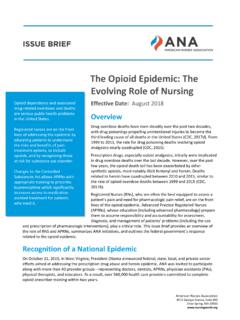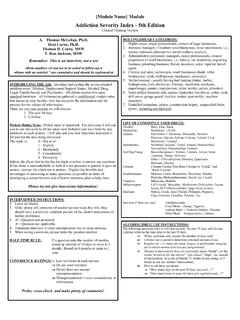Transcription of Opioid Agonist Therapy - CAMH
1 Opioid Agonist Therapy : A Synthesis of Canadian Guidelines for Treating Opioid Use Disorder Centre for addiction and Mental Health. Opioid Agonist Therapy : A Synthesis of Canadian Guidelines for Treating Opioid Use Disorder. Published May 2021. Available at ContentsIntroduction 1 Opioid use disorder and treatment ..1 Background .. 2 Audience .. 3 Scope and process .. 3 Acknowledgment of other guidelines ..4 Structure .. 4 Key acronyms and terms ..5 Additional resources .. 5 Disclaimer .. 6 Acknowledgments 7 Part A: Preparing to provide Opioid Agonist Therapy 11A1.
2 Reducing harm .. 11A2 . Engaging patients in treatment .. 12A3 . Building relationships with patients and other health care and service providers .. 13A4 . Expectations for prescribers of Opioid Agonist Therapy .. 14A5 . Initiating Opioid Agonist Therapy ..15A6. Effective use of ECGs .. 16A7. Effective use of urine drug testing .. 17A8 . Providing prescriptions for Opioid Agonist Therapy ..19 Part B: Providing different forms of Opioid Agonist Therapy 21B1 . Choosing a pharmacological treatment .. 21B2 . Prescribing buprenorphine/naloxone.
3 23B3 . Prescribing methadone .. 25B4 . Prescribing slow-release oral morphine .. 28B5 . Prescribing injectable Opioid Agonist Therapy ..30B6 . Prescribing take-home doses .. 33 Part C: Providing Opioid Agonist Therapy in specific settings and populations 34C1 . Rural and remote settings .. 34C2 . Virtual care (telemedicine) ..34C3 . Pregnant and postpartum women .. 35C4 . Patients who are hospitalized ..36C5 . Patients who are incarcerated .. 37C6 . Transition-aged youth .. 39 Part D: Providing Opioid Agonist Therapy for patients with co-occurring disorders 40D1.
4 General considerations .. 40D2 . Mental health and addiction considerations .. 40D3 . Infectious disease considerations .. 41D4 . Acute and chronic pain considerations .. 42 Part E: Discontinuing Opioid Agonist Therapy 44E1 . Transferring care .. 44E2 . Tapering and withdrawal management .. 45 Key Opioid use disorder treatment guidelines 461 | Opioid Agonist Therapy : A SYNTHESIS OF CANADIAN GUIDELINES FOR TREATING Opioid USE DISORDERI ntroductionIntroductionOpioid use disorder and treatmentOpioid use disorder (OUD) is a chronic, relapsing condition that has significant personal, public health and economic consequences.
5 Many of the fatal and non-fatal overdoses in Canada s epidemic over recent years have occurred in people with OUD. OUD may involve prescription medications (including medications that have been diverted from the medical system), or illicitly manufactured opioids, such as heroin or highly potent street fentanyl and fentanyl can achieve sustained long-term remission from OUD with effective treatment and follow-up. The first-line treatment for moderate to severe OUD is Opioid Agonist Therapy (OAT), ideally combined with behavioural and social supports to optimize the determinants of health and address other psychosocial factors that influence substance use and quality of life.
6 OAT can stabilize the cycle of intoxication and withdrawal, reduce Opioid cravings and block the intoxicating effects of other short-acting opioids, including fentanyl. People who are maintained on OAT typically experience significantly improved health and social functioning and a considerable reduction in the risk of overdose and all-cause people do not meet criteria for OUD, yet inject or use illicit drugs that can lead to poisonings, overdose and death. This guideline is not applicable to the management of people in these situations, and recommendations for programs and services to address their needs are beyond the scope of this | Opioid Agonist Therapy : A SYNTHESIS OF CANADIAN GUIDELINES FOR TREATING Opioid USE DISORDERI ntroductionBackgroundEach provincial medical regulatory authority (MRA) has its own set of guidelines and standards for OAT.
7 The aim of this unified guideline is to standardize expectations for Canadian prescribers, but not to replace any adopted guidelines; rather, this guideline was developed to complement existing initiatives and to support prescribers with best practices and evidence. It serves as a guideline of guidelines by synthesizing key recommendations for treating and managing OUD from existing standards, guidelines, expert opinions and best practices across development of this guideline was supported by the following MRAs: College of Physicians and Surgeons of Alberta College of Physicians and Surgeons of British Columbia College of Physicians and Surgeons of Manitoba College of Physicians and Surgeons of Newfoundland and Labrador College of Physicians and Surgeons of Ontario College of Physicians and Surgeons of Prince Edward Island College of Physicians and Surgeons of SaskatchewanThe role of the MRAs in regulating the management of OUD varies across the country.
8 Some MRAs write clinical guidelines, provide education and have quality assurance programs that ensure safe OAT prescribing, while in other jurisdictions some of these roles are performed by independent organizations. However, what the MRAs have in common is holding registrants accountable to standards of practice. Prescribers should contact their MRA for specific guidance on this guideline and to clarify regulatory expectations for managing | Opioid Agonist Therapy : A SYNTHESIS OF CANADIAN GUIDELINES FOR TREATING Opioid USE DISORDERI ntroductionAudienceThe primary audience for this document is physicians who prescribe treatment for OUD.
9 However, this guideline may be used by other health care professionals who are authorized to prescribe and processEstablishing new evidence was beyond the scope of this project. Rather, the aim was for representatives from each of the participating MRAs and independent reviewers to reach consensus regarding recommendations from existing guidelines (see the Key Opioid use disorder treatment guidelines section). Targeted searches of peer-reviewed and grey literature were conducted in the cases of guideline discrepancies or topics with varying degrees of evidence. This document is the outcome of that process: it is a product of synthesized guidelines blended with expert opinions and evidence-based guideline was developed using an iterative process that involved three groups: a subject matter expert group, an MRA advisory committee and an external reviewer panel.
10 Each MRA nominated two subject matter experts and one MRA representative. The subject matter experts reviewed existing guidelines and literature and helped to develop the recommendations in this document. The MRA representatives reviewed the recommendations to ensure that they conform to regulatory standards. An external panel of clinical experts who do not have clear ties to an MRA, as well as people with lived experience, then reviewed the recommendations. The subject matter expert group considered their feedback in finalizing the | Opioid Agonist Therapy : A SYNTHESIS OF CANADIAN GUIDELINES FOR TREATING Opioid USE DISORDERI ntroductionAcknowledgment of other guidelinesAlthough the process of developing this document involved reviewing and synthesizing recommendations from existing guidelines, two guidelines in particular were important in developing this document.


